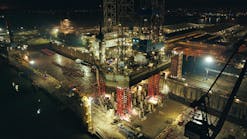Russell Krohn
Pride International
As the search for oil continues to voyage into deeper waters, field development needs differ. To meet this variety, Pride International will offer four newly designed vessels to be outfitted in several configurations dependent on the requirements of its clients.
Pride'sDeep Ocean Ascension.
Historically, floating offshore rigs were configured with a single-load path from a derrick. This limits off-line capabilities. In the 1990s, the dual-load paths capability from a single derrick design was introduced. Dual-load paths from the derrick enhances efficiency by making it possible to run certain operations concurrently. With the new design of Pride’s ultra deepwater drillships, a third off-line load path has been included with the addition of a large capacity, active heave compensated crane.
Each the new drillship can be outfitted with a traditional single-activity well center with offline drillstring and casing stand building capabilities. The more modern dual-activity well center with offline stand building capabilities also can be selected. The client can opt for the additional offline subsea construction capability made possible by the addition of the crane.
This crane active heave compensated 160-metric ton (176-ton) knuckle boom crane is essential for modern drillships involved in production and field development. The crane is outfitted to run equipment to the sea floor in 10,000 ft (3,048 m) of water. It gives the client the ability to run subsea trees and templates, and also to test and run umbilicals. It also can assist the ROV unit required to support drilling operations.
This flexibility means the client can request deepwater drillships with capabilities ranging from single activity drilling combined with subsea construction capabilities all the way to the triple activity rig with all of the latest technology the new drillships offer, or any combination in between. In addition, all four of the new rigs as presently outfitted offer time saving off-line activity such as stand building of drillpipe, collars, bottomhole assemblies (BHA), and casing.
New systems, efficient operations
Also included in the design of the new ultra deepwater drillships is new equipment that allows more efficient drilling. One of the most critical elements in deepwater operations is the riser system. In selecting a riser system design for its drillships, Pride conducted studies to select the most appropriate system to improve the safety, reliability, and efficiency of the riser systems.
These studies covered the design of the handling, storage, and maintenance of the riser, as well as the riser design itself. Based on these requirements, Pride selected the MR-6H SE, a new design by Vetco that is based on Vetco’s proven connector technology for the riser coupling.
Pride believes this riser connection design is the safest and most efficient on the market. It is designed to function as a pre-loaded connection in all conditions, which minimizes the effects of fatigue. The MR-6H SE combines all the improvements of the new generation of riser systems and is expected to improve the efficiency of riser operations by 20% compared with conventional bolted connections. The new design virtually eliminates manual intervention to reduce the risk of injury to rig personnel.
Another efficiency included in Pride’s new-generation rigs is the active mud system. This is a 6,000-bbl system that can be configured to a 6,000-bbl mud system, a 6,000-bbl brine system, or a double-isolated, split mud and brine system, giving each 3,000-bbl capacity. This allows independent use mud and brine. The double isolation between systems safeguards against mud/brine cross-contamination.
In addition to the active mud system, each new vessel can store 2,800 bbl of oil-based mud, 7,000 bbl of brine fluids, and 7,400 bbl of additional reserve mud. The combination of the active and bulk storage capacities provides a flexible drilling fluid management system.
Pride’s philosophy for its vessels is to provide sufficient power to complete any current drilling operation while maintaining station-keeping ability in DP-3 conditions. The new rigs are designed to have six main engine generators delivering 42,000 kW of power. The main engines or generators, switchgear, and all other station-keeping components are configured to obtain the ABS class/DP-3 designation. Each vessel is outfitted with six azimuthing-type thrusters, each rated for 5,500 kW.
Subsea embraced
With the delivery of the first ship scheduled for early 2010, the company has named the new vessels after major subsea features:
- Deep Ocean Ascension (formerly the PS1) -- scheduled for completion 1Q 2010
- Deep Ocean Clarion (formerly PS2) -- scheduled for completion 3Q 2010
- Deep Ocean Mendocino (formerly PS3) -- scheduled for completion 1Q 2011
- Deep Ocean Molokai (formerly PS4) -- scheduled for completion 4Q 2011.
Ascension, Clarion, Mendocino, and Molokai are undersea fracture zones that occur in some of the deepest areas of the oceans.
These four rigs are based on the Samsung Saipem 10000 hull, with a length of 750 ft (228.6 m) and a breadth of 137.8 ft (40 m). They are ABS class/DP-3 drillships with high variable deck load, large deck space for third party or client equipment and a large accommodation capacity of up to 200 personnel. Each has 12,000-ft (3,657.6-m) maximum water depth, with 2 X 1,000 tons of hook load. Each is designed to operate in the waters of the Gulf of Mexico, Brazil, West Africa, and Southeast Asia. The first two ships have been contracted by BP (Deep Ocean Ascension and Deep Ocean Clarion) and Petrobras has contracted Deep Ocean Mendocino.







